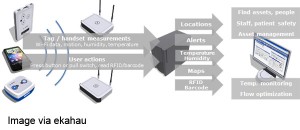Hospitals Get Smart with Latest Interactive Patient Care Solutions
By Warren Kressinger-Dunn
Today’s hospitals are facing a virtual tidal wave of demand for healthcare services based on several factors: an aging baby boomer population that requires more intensive care and more of it, new healthcare legislation that is extending eligibility to thousands of newly-insured patients and emerging treatment modalities offering the potential to extend lifetimes to the longest in history.
Complicating matters is an anticipated global healthcare provider shortage, which is threatening the ability of healthcare delivery organizations (HDOs) to meet the growing need for services. As a result, HDOs are aggressively seeking ways to re-tool their operations to provide care more efficiently and cost-effectively to an increasing number of patients, without compromising quality or their own financial bottom lines.
High-Tech Improves Coordination of Care
Fortunately, one of the latest trends in Healthcare IT may provide a partial answer to the crisis in the form of new Interactive Patient Care (IPC) solutions that promise to improve clinical workflow and staff efficiency, while enhancing the patient experience. New and re-purposed technologies are converging to equip the hospital enterprise with a user-friendly IT platform that streamlines numerous processes while empowering patients with tools to personalize their stay and optimize their recovery.
Hospitals are rapidly adopting Radio Frequency Identification (RFID) and Real Time Locating Systems (RTLS) technologies throughout their facilities to automatically identify clinicians and patients and deliver a wealth of patient data to caregivers at the point of care. Featuring built-in security parameters, RFID and RTLS capabilities ensure access to specific patient information only by authorized individuals, so that sensitive data is always protected.

These technologies are now providing value far beyond simple inventory tracking and equipment monitoring in facilities, creating opportunities for a more streamlined, coordinated approach to patient care on behalf of the entire healthcare team. Today’s IPC solutions are designed to increase clinician productivity and enhance both patient safety and comfort. Having a patient’s up-to-date medical history and current medications at your fingertips is the key to safely and effectively delivering optimum care while reducing the administrative burden.
A Portal in the Storm of Information
By combining these automated identification capabilities with new networked, smart terminals located at the point of care, these fully integrated solutions provide a convenient portal to information, services and a diverse array of capabilities for clinicians, staff and patients alike.
Today’s bedside smart terminals come in all shapes and sizes to provide the utmost comfort, control and convenience for both patients and clinicians within the confines of the hospital room. Typically comprising a medical grade all-in-one computer, these consoles are available in wall-, ceiling-mounted or tabletop options for easy viewing and mobility. User-friendly graphic interfaces, similar to smartphone menus, make applications easily accessible via an anti-bacterial touchscreen. Patients can select from a wide array of functions to make their stay more personalized, from ordering their evening meal to checking their daily schedule or simply adjusting the room lighting.
The best-performing solutions offer a turnkey approach to interactive patient care systems, bundling proprietary software with the terminals to ensure seamless operation and smooth connectivity. Many also feature sound ergonomics and sleek styling, in addition to energy-saving LED backlights for a truly “green” approach to bedside computing.
Clinician Collaboration Goes Mobile
 Clinicians can also use bedside smart terminals to build a rapport with patients, employing these user-friendly tools as an interactive “whiteboard” to communicate more clearly and completely about a patient’s course of treatment. While a patient rests comfortably in bed, the doctor can pull up their latest MRI scan, show a video depicting the upcoming surgical procedure, and provide post-operative instructions to illustrate the continuum of care in a meaningful, understandable way.
Clinicians can also use bedside smart terminals to build a rapport with patients, employing these user-friendly tools as an interactive “whiteboard” to communicate more clearly and completely about a patient’s course of treatment. While a patient rests comfortably in bed, the doctor can pull up their latest MRI scan, show a video depicting the upcoming surgical procedure, and provide post-operative instructions to illustrate the continuum of care in a meaningful, understandable way.
Staying Connected for Better Outcomes
In addition to learning more about their condition and course of treatment, patients can utilize smart terminals to access a diverse palette of entertainment and communication apps, allowing them to stay connected, both inside and outside the hospital, during their stay. Armed with a fully-optimized, ergonomic monitor, patients can quickly and easily access television, movies, radio, Internet, email, games, video conferencing and more to make their recuperation more enjoyable.
Hospitalized patients can also use the terminal to communicate with hospital workers, control their room environment, request special meals and view their daily schedule to feel more in control of their experience. It goes without saying that the patient “self-service” aspects of bedside smart terminals can also free up medical staff to attend to more critical tasks and provide better care in a more timely manner.
 Education Promotes Long-Lasting Recovery
Education Promotes Long-Lasting Recovery
Another key benefit, is that patients and their families can view educational brochures and videos about their specific medical condition, including follow-up care, to learn ways to enhance their opportunities for a full recovery. It’s no surprise that a well-informed patient is likely to have a more successful recuperation and return to good health more quickly. We are seeing that patients actively engaged throughout their hospitalization typically experience greater overall satisfaction, which can also positively influence their clinical outcome.
Hospitals Re-tool for Efficiency
Patients who have taken an active role in their care and treatment are often more likely to continue healthy habits upon their return to home. For an HDO, successful patient outcomes can result in fewer re-admissions due to potential complications or relapses. With fewer re-admissions, hospitals can benefit from faster bed turnarounds to accommodate new, incoming patients.
In addition to their clinical advantages, IPC solutions can also aid healthcare administrators in significantly improving operational efficiency throughout the hospital enterprise. Anything that empowers clinicians and staff to increase their productivity and throughput is going to benefit an institution’s bottom line.
Hospitals can leverage the networked communications and information-sharing capabilities of IPC solutions to reduce the administrative burden on providers and staff, primarily by eliminating repetitive data entry and automating many routine tasks. Also, by integrating these solutions into the hospital’s nurse call systems, hospitals can enable caregivers to prioritize and more fully respond to requests while allowing patients to obtain exactly the type of assistance needed. For the hospital, these types of modifications can enable a smarter approach to staffing and clinician coverage, which in turn, improves utilization of resources across the enterprise.
Creating New Revenue Streams
 The flexibility of the platform also enables hospitals to package and upsell premium patient entertainment packages to create a new source of revenue stream, complete with integrated billing systems for true self-service entertainment. This may also be a benefit that prompts patients to rate their hospital highly when it comes to satisfaction surveys. The bedside smart terminal makes this easy! Hospitals can offer online patient satisfaction surveys right on the device, potentially using positive results to secure higher reimbursements from many healthcare insurers. Patients can take surveys anytime during, and at the conclusion at their stay, providing feedback on numerous parameters which can be used by healthcare administrators to continue improving the delivery of care.
The flexibility of the platform also enables hospitals to package and upsell premium patient entertainment packages to create a new source of revenue stream, complete with integrated billing systems for true self-service entertainment. This may also be a benefit that prompts patients to rate their hospital highly when it comes to satisfaction surveys. The bedside smart terminal makes this easy! Hospitals can offer online patient satisfaction surveys right on the device, potentially using positive results to secure higher reimbursements from many healthcare insurers. Patients can take surveys anytime during, and at the conclusion at their stay, providing feedback on numerous parameters which can be used by healthcare administrators to continue improving the delivery of care.
From a cost-containment perspective, hospitals typically benefit from the bundling benefit of IPC solutions, i.e., sole-sourcing TV/telephone/Internet platform and services, which typically results in a lower total cost of ownership for these items when not combined.
Paving a New Path to Quality Care
IPC solutions can play a vital role in ensuring the continuity and quality of patient care, closing the resource gap with innovative, self-service tools that benefit patients, clinicians and the entire hospital enterprise. By adopting these bedside smart terminals in their facilities, healthcare delivery organizations can continue their mission of safely and cost-effectively delivering high-quality patient care in a new era of growing demand for services.
Warren Kressinger-Dunn is vice president of strategic marketing, Point of Care for Barco Healthcare. In his current role, he leads the corporate strategic direction and product development for Barco’s Point of Care solutions. Bringing more than 25 years of experience in the electronics industry, Kressinger-Dunn joined Barco during its acquisition of JaoTech where he formerly served as the company’s chief executive officer.


